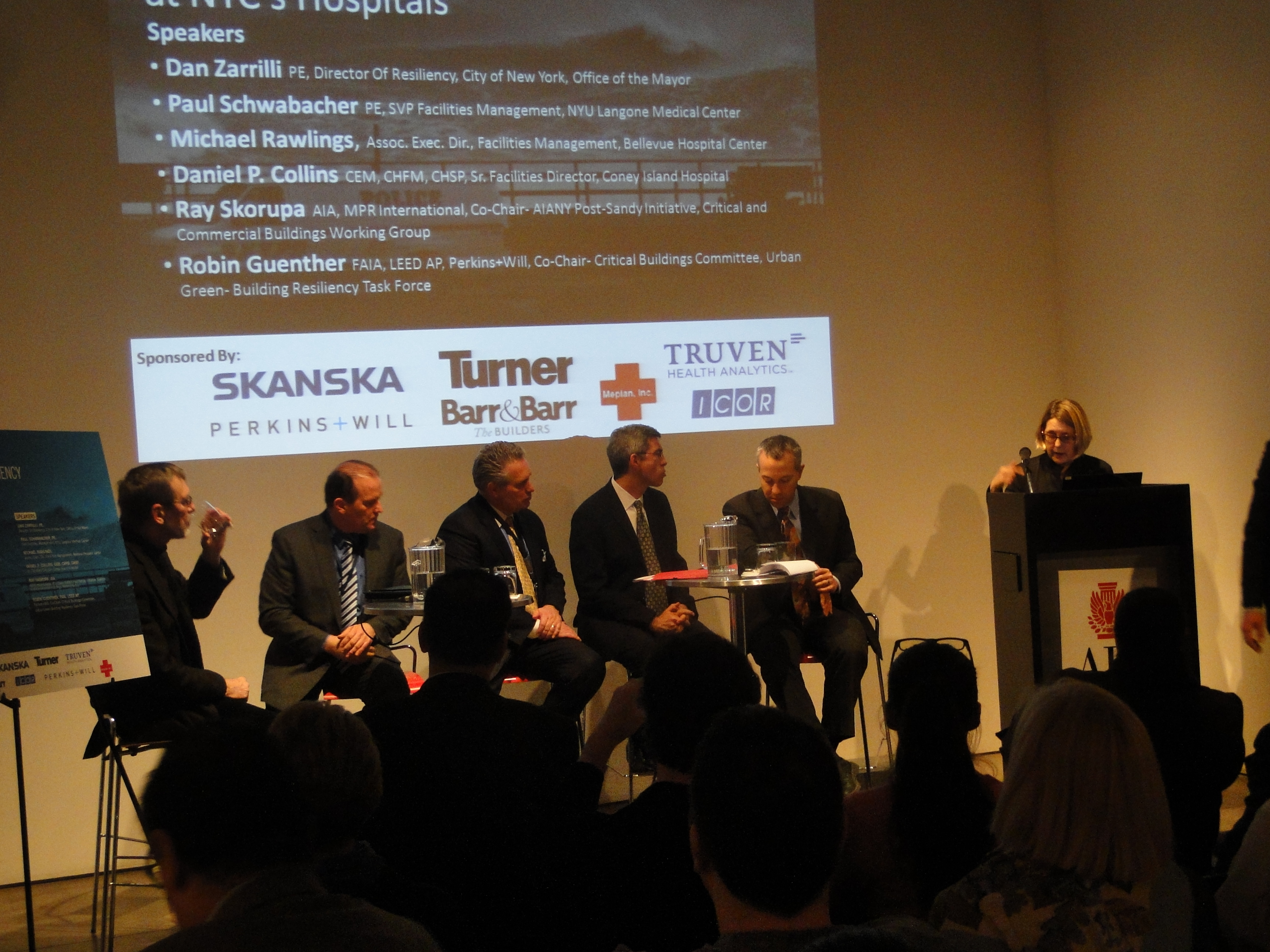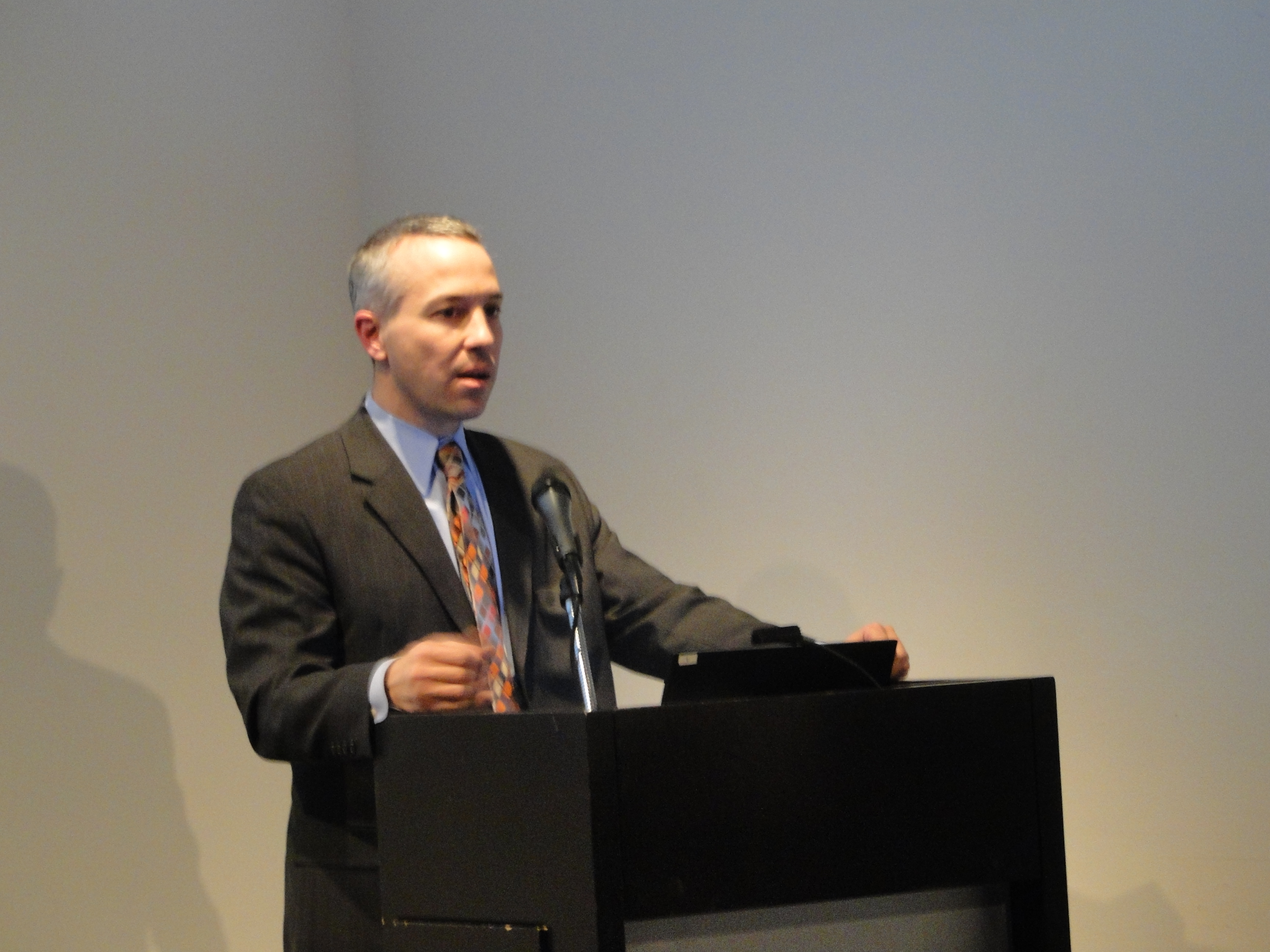by: JasonHarper
On 02.26.14, a packed Tafel Hall was the setting for “After Sandy: Recovery and Resiliency and NYC’s Hospitals,” which examined the impact of the storm on New York City’s hospitals, how its effects are still being felt 16 months later, and efforts to increase hospitals’ resilience. The storm was a devastating wake-up call for all involved in the operation and design of hospitals in the city, causing the closing of six hospitals and the emergency evacuation of 6,500 patients from hospitals and nursing homes throughout the city. The program took a detailed look at three of the hospitals most impacted by the storm, as well as the response of the city and AIANY through the formation of post-Sandy task forces that made recommendations to increase hospitals’ resiliency against future climate change-driven storms such as Sandy.
The program was co-organized by the AIANY Design for Risk and Reconstruction Committee (DfRR), The New York Society for Health Planning (NYSHP), and the AIANY Health Facilities Committee (HFC). AIANY Chapter President Lance Jay Brown, FAIA, opened the evening with a discussion of the meaning of the term “resilience” and related nomenclature. Brown also congratulated the Chapter’s Post-Sandy Initiative, led by DfRR, which recently received the 2014 AIA National Award for Collaborative Achievement. Nancy Victor of NYSHP spoke briefly on the critical importance of strengthening the resilience of the health care system and NYSHP’s work in this regard. Jason Harper, AIA, HFC co-chair, introduced the panel, which included facility directors of three of the hospitals most impacted by the storm, as well as representatives of three post-Sandy initiatives, including those of the NYC Mayor’s Office, Urban Green, and the AIA New York Chapter.
Up first was Dan Zarrilli, PE, director of the NYC Mayor’s Office of Long Term Planning and Sustainability, who set the scene by describing Sandy’s impact in the context of ongoing climate change. He stated that the storm reduced the hospital bed capacity in the city by 8% in its immediate aftermath, and how 5% of the beds in the city remained down for more than four weeks after the storm as facilities recovered. He pointed out that the effect on the city’s outpatient facilities was more limited, but was concentrated in the city’s most devastated communities. He explained that currently 18% of the city’s inpatient beds are located within the 500-year flood zone, but that sea level rise is anticipated to increase this number to 20% by 2020, with similar increasing risk to nursing home and adult care facility beds.
Zarrilli went on to describe how, in the storm’s aftermath, the city set up the Special Initiative for Rebuilding and Resiliency (SIRR) to examine ways to strengthen critical infrastructure and rebuild neighborhoods, not just as they were, but better than before. He explained the city’s plan to make all New Yorkers safer in a multi-layered approach to increasing resiliency that addresses strengthening coastal defenses, upgrading individual buildings, protecting critical infrastructure and services by hardening assets and expanding natural infrastructure, and ways to make our neighborhoods safer and more vibrant by reducing the risks they face. He also talked about plans outlined in the PlaNYC SIRR report, which include 12 healthcare-specific initiatives targeting the 11 hospitals, 18 nursing homes, and 18 adult care facilities within the 500-year flood zone. Key City Council legislation passed in 2013 includes Local Law 95, which increases requirements for flood-resistant construction for healthcare facilities, Local Law 100, which mandates that flood-prone critical building systems, such as electrical and fire protection systems, be located above flood elevations in both new and renovated buildings, and Local Law 108, which calls for new and existing facilities to install “quick-connect” mobile generator hook-ups by 2033. Zarrilli also mentioned a crucial piece of future legislation being given priority, which includes a mandate for all critical facilities within the 500-year flood plane to elevate or otherwise flood-protect all critical building systems by 2030.
Paul Schwabacher, PE, described the impact of Sandy on the NYU Langone Medical Center (NYULMC), from which all patients had to be evacuated after 14 feet of water inundated the lower levels of the hospital, knocking out both normal and emergency power systems and all elevators in the facility. At the time of the storm, NYULMC was in the process of implementing a long-term campus transformation plan for which work is ongoing. This plan includes extensive resiliency measures, such as the elevation of all power systems, increased system redundancy, elevation of critical systems, patient care, and support functions, the creation of a new co-generation power plant on site, and new elevators that do not extend to the lower levels so that they can remain in service in the event of a similar storm in the future. These plans were modified to incorporate resiliency features in response to lessons learned from Sandy, such as plans for the creation of a continuous sea wall encompassing the main campus to a height of up to two feet above the 500-year flood advisory level.
Michael Rawlings said the impact of the storm was devastating at the Bellevue Hospital Center, the flagship of New York City’s Health and Hospitals Corporation (HHC) system, where he is facility director. The interconnected basement levels of all five buildings on the Bellevue campus were inundated by rising flood waters from the East River, knocking out all major building systems. He described how this forced the evacuation of all 723 patients over five days without power or elevators, but was was accomplished safely. The resiliency measures that have been put in place at Bellevue in the wake of the storm include the elevation of critical building systems and emergency flood barriers, as well as additional resiliency measures that are being planned in future projects.
Daniel Collins, director of facilities at Coney Island Hospital, also an HHC hospital, said ocean tidal surge flooding inundated almost the entire Coney Island peninsula, including the entire Coney Island Hospital site, knocking out all utilities, emergency backup systems, and communications. He described how the loss of the hospital’s emergency department, a crucial resource to the South Brooklyn community, impacted the EDs of the nearest hospitals that remained in operation, including Maimonides, Lutheran, and Beth Israel King’s Highway, each of which saw sustained increases to their patient intake volumes of up to 50%, which stressed Brooklyn’s already overburdened healthcare system for many weeks following the storm. Collins explained the hospital’s performance criteria for mitigation, with primary responsibility placed on maintaining life safety. Maintaining operation of the Emergency Department was considered the next highest priority, with the parallel priority of protecting critical systems and assets from future flood risk.
Following the three hospital presentations, Ray Skorupa, AIA, of MPR International, discussed the work of the AIANY Post-Sandy Initiative, for which he served as co-chair of the Critical and Commercial Buildings working group. The Post-Sandy Initiative report focuses on climate-driven disasters and the impacts of flooding, high winds, and temperature. The critical facility category includes hospitals, nursing homes, and police and fire department facilities. In addition, the commercial building category includes communication and fuel distribution facilities, which were found to be vulnerable during Sandy. The report outlines four main areas: vulnerability assessment, technical standards needing revision, operational planning, and implementation planning. The report provides recommendations for building structural and enclosure systems, as well as 14 crucial building infrastructure systems to increase their resiliency.
Robin Guenther, FAIA, of Perkins+Will, described the Urban Green Council Building Resiliency Task Force report, which was produced at the request Mayor Michael Bloomberg and City Council Speaker Christine Quinn. Guenther served as co-chair of the Task Force’s Critical Buildings Committee. The primary focus was on recommending measures and building code changes that would increase resilience. Of the 34 recommendations outlined in the report, 16 have been implemented by the city and five have been introduced in the City Council for action. Nine others remain proposals, and four recommendations are voluntary. Details of each proposal and its current status on the road to implementation by the City Council can be found at the Urban Green Task Force’s online tracker here.
Jason Harper, AIA, is co-chair of the AIANY Health Facilities Committee.
Event: After Sandy: Recovery and Resiliency at NYC’s Hospitals
Location: Center for Architecture, 02.26.14
Speakers: Lance Jay Brown, FAIA, 2014 AIANY President and DFRR Co-Chair; Jason Harper, AIA, HFC Co-Chair; Nancy Victor, NYSHP Program Committee Chair (Introductions); Daniel Zarillii, PE, Director of Resiliency, Mayor’s Office, City of New York, NYC Special Initiative for Rebuilding and Resiliency (Overview); Paul Schwabacher, PE, Senior Vice President, Facilities Management; Michael Rawlings, Associate Executive Director, Facilities Management; Daniel Collins, PE, Director, Facilities Management (Case Studies); Robin Guenther, FAIA, Principal, Perkins+Will, Co-Chair, Critical Buildings Committee; and Ray Skorupa, AIA, Principal, MPR, Co-Chair, Critical and Commercial Buildings Committee (Agency Response)
Organizers: AIANY Health Facilities Committee (HFC); AIANY Design for Risk and Reconstruction Committee (DfRR); and the New York Society for Health Planning (NYSHP)
Sponsors: Turner (Lead Sponsor), Barr & Barr, ICOR Consulting Engineers, Meplan, Inc., Perkins+Will, and Skanska (Sponsors)











